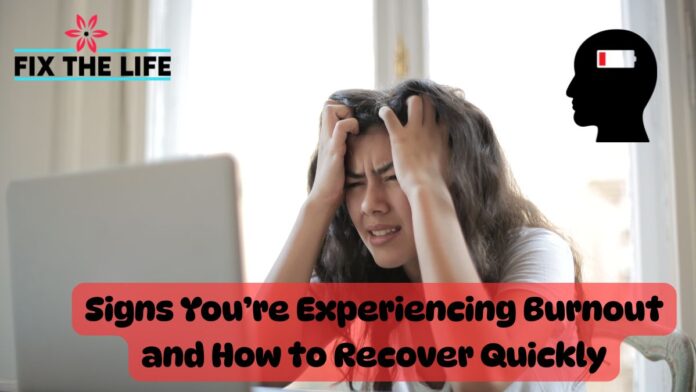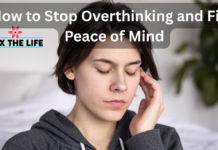Burnout is more than just feeling tired or stressed. It’s a state of physical, emotional, and mental exhaustion caused by prolonged stress — often from work, caregiving, or constant pressure to perform. Left unchecked, it can affect your productivity, relationships, and overall well-being. Recognizing burnout symptoms and recovery strategies early is crucial to regaining control and restoring your health.
What Is Burnout?
Burnout is a psychological condition triggered by chronic stress, particularly in demanding environments. Unlike occasional fatigue, burnout lingers and can worsen if ignored. It was officially classified by the World Health Organization as an occupational phenomenon, but it affects people from all walks of life.
While work is a common source, personal responsibilities, caregiving, and social pressures can contribute too. Understanding the symptoms is the first step toward recovery.
Common Signs You’re Facing Burnout
Burnout symptoms and recovery awareness begins by identifying warning signals. Here are key signs you might be dealing with burnout:
- Chronic Exhaustion: Constant fatigue that sleep doesn’t fix. You wake up tired and stay that way, mentally and physically drained.
- Emotional Detachment: You may start feeling indifferent or emotionally numb about things you once cared about. Work, hobbies, and relationships can feel meaningless.
- Increased Irritability: Small frustrations feel overwhelming, and your patience runs thin. You might snap at coworkers, friends, or family.
- Lack of Motivation: Tasks you once tackled with enthusiasm now feel like heavy burdens. Procrastination and apathy become daily struggles.
- Physical Symptoms: Headaches, digestive problems, muscle tension, or insomnia are common physical reactions to burnout.
- Declining Performance: Despite working longer hours, your focus, creativity, and productivity drop.
Example: If you find yourself rereading emails multiple times because you can’t concentrate, or dreading meetings that once energized you, these are classic burnout red flags.
Causes of Burnout
Identifying the source of your stress can help you address it effectively. Common causes include:
- Excessive workload and unrealistic deadlines.
- Lack of control over your schedule or decisions.
- Poor work-life balance with no time for rest.
- Emotional strain from caregiving or personal crises.
- Isolation, either socially or professionally.
- Perfectionism or fear of failure.
Knowing what’s fueling your burnout is key to choosing the right recovery strategy.
Effective Recovery Strategies
The good news is that burnout is reversible. Here’s how to start healing and restoring balance:
1. Prioritize Rest and Sleep
Burnout thrives on exhaustion. Make rest a non-negotiable part of your routine. Aim for 7-9 hours of quality sleep and allow yourself guilt-free downtime. Even short breaks throughout the day can help reset your mind.
2. Set Clear Work-Life Boundaries
Maintaining a healthy work-life balance protects you from overextending yourself.
Practical tips:
- Log off work emails after hours.
- Avoid multitasking.
- Schedule personal time like you would a work meeting.
3. Reconnect with Enjoyable Activities
Rediscover hobbies or interests that once made you happy. Creative activities, reading, walking, or simply listening to music can provide essential mental breaks.
4. Seek Support
Talk to trusted friends, family, or a mental health professional. Sometimes just voicing your struggles lightens the emotional load.
5. Practice Mindfulness and Relaxation Techniques
Incorporating mental health tips like meditation, deep breathing exercises, or yoga can reduce stress and promote calmness. Even five minutes a day makes a difference.
6. Reassess Priorities
Not everything needs to be done immediately or perfectly. Learn to say no, delegate tasks, and focus on what truly matters.
When to Seek Professional Help
If burnout symptoms persist despite lifestyle adjustments, it’s time to consult a therapist or counselor. Professional guidance can offer tailored coping strategies and address underlying issues like anxiety or depression.
Recommendation
Top 7 Digital Detox Tips for a Healthier, Happier Life
The Benefits of Concierge Medicine: A Personalized Approach to Healthcare
Related Subspecialties in Internal Medicine and Employment Settings
Top 10 Self-Care Activities to Try This Weekend for Instant Relaxation
How to Build a Morning Routine That Actually Sticks in 2025
FAQ
Q1: How do I differentiate between stress and burnout?
A: Stress is usually short-term and tied to specific situations. Burnout is chronic, leaving you emotionally and physically depleted, detached, and consistently unmotivated.
Q2: Can burnout affect physical health?
A: Yes. It can cause headaches, insomnia, digestive issues, muscle tension, and a weakened immune system, making you more susceptible to illness.
Q3: How long does it take to recover from burnout?
A: Recovery times vary. Mild burnout can improve in a few weeks with lifestyle changes, while severe cases may take months and professional support.
Q4: Can adjusting my work habits really help?
A: Absolutely. Setting boundaries, taking regular breaks, and reevaluating your workload are proven ways to prevent and manage burnout.
Q5: Are there quick mental health tips for stressful days?
A: Yes. Try deep breathing exercises, a short outdoor walk, listening to calming music, or a digital detox for 10-15 minutes to reset your mood and energy.
Final Thoughts
Understanding burnout symptoms and recovery techniques is essential for protecting your mental and physical health. Burnout doesn’t just resolve on its own — but with intentional rest, clear boundaries, and supportive habits, you can reclaim your energy, passion, and peace of mind. Remember, prevention is easier than recovery, so prioritize self-care and keep an eye on your stress levels.




